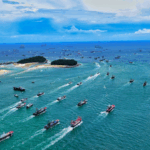Chinese experts warn that U.S.-led militarization in the South China Sea is set to grow, regardless of who occupies the White House 🏛️. But here's the twist: they’re cautiously optimistic about the region's long-term stability. Let’s dive in! 🚀
What’s Fueling the Tensions?
At a recent forum hosted by the South China Sea Strategic Situation Probing Initiative (SCSPI), analysts revealed that U.S. military activity in the region is off the charts—over 5,000 ship-days and 8,000 aircraft sorties annually. 🚢✈️ 'The U.S. presence will keep rising, but tactics might shift with leadership changes,' said Wu Shicun of China's National Institute for South China Sea Studies.
The Rulebook Dilemma 📜
Experts highlighted the 2002 Declaration on Conduct (DOC)—a pact between China and ASEAN to avoid clashes. But Wu called it a 'simplified' tool that struggles to rein in nations pushing unilateral agendas. Think of it as a TikTok dance tutorial: everyone knows the steps, but some still freestyle. 💃
Philippines Plays the Game 🎯
The Philippines, locked in maritime disputes with China, might try leveraging U.S.-China rivalry to boost its claims. But Professor Hu Bo from Peking University isn’t sold: 'The U.S. isn’t eager to get dragged into territorial spats.' Meanwhile, analysts predict Manila could pass laws to cement its claims—like saving your spot in a crowded food court. 🍜
Why Stability Still Wins 🛡️
Despite the drama, experts say the South China Sea isn’t the 'war zone' some media paint. 1.5 million ships pass through annually, handling 40% of global trade. Both China and the U.S. share a 'no-war' pact, prepping for worst-case scenarios while avoiding direct clashes. It’s like two gamers trash-talking online but never hitting 'unfriend.' 🎮
Bottom line? The South China Sea remains a hotspot, but don’t expect the lid to blow off just yet. Stay tuned! 🔥
Reference(s):
U.S. militarization of South China Sea to grow, but stability remains
cgtn.com







